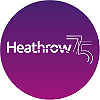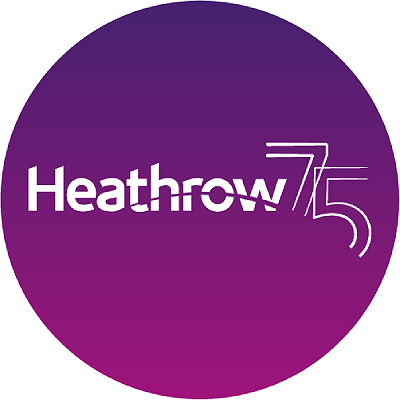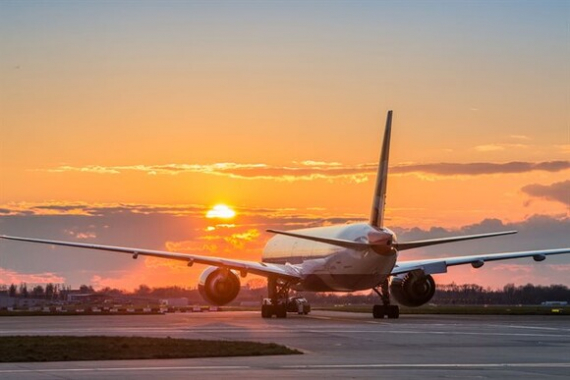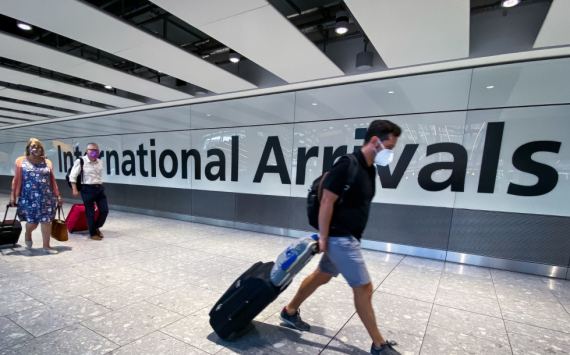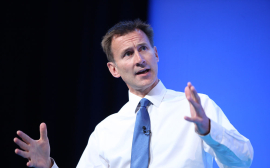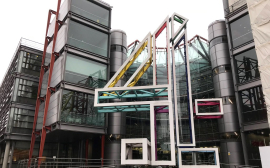Description
Heathrow Airport originally called London Airport until 1966 and now known as London Heathrow, is a major international airport in London, England. It is one of six international airports serving the London region. The airport facility is owned and operated by Heathrow Airport Holdings. In 2019, it was the second busiest airport in the world by international passenger traffic, the seventh busiest airport in the world by total passenger traffic, and the busiest airport in Europe by passenger traffic.
Heathrow was founded as a small airfield in 1929, but was developed into a much larger airport post-World War Two. The airport, which lies 14 miles (23 km) west of Central London on a site that covers 12.27 square kilometres (4.74 sq mi), gradually expanded over the next seventy-five years, and now has two parallel east–west runways along with four operational passenger terminals, and one cargo terminal. The airport is the primary hub for British Airways and the primary operating base for Virgin Atlantic; in 2019, it handled a record 80.8 million passengers, a 0.9% increase from 2018, as well as 475,861 aircraft movements.
In September 2012, the Government of the United Kingdom established the Airports Commission, an independent commission chaired by Sir Howard Davies to examine various options for increasing capacity at UK airports. In July 2015, the commission backed a third runway at Heathrow, which the government approved in October 2016. However, the England and Wales Court of Appeal rejected this plan for a third runway at Heathrow, on the basis that the government failed to consider climate change and the environmental impact of aviation. On 16 December 2020, the U.K. Supreme Court lifted the ban on the third runway expansion, allowing the construction plan to go ahead.
Location
Heathrow is 14 mi (23 km) west of central London, on a parcel of land that is designated part of the Metropolitan Green Belt. It is located 3 mi (4.8 km) west of the town of Hounslow, 3 miles south of Hayes, and 3 miles north-east of Staines-upon-Thames.
The airport is surrounded by the villages of Sipson, Harlington, Harmondsworth, and Longford to the north and the neighbourhoods of Cranford and Hatton to the east. To the south lie Feltham, Bedfont and Stanwell while to the west Heathrow is separated from Wraysbury, Horton and Windsor in Berkshire by the M25 motorway. Heathrow falls entirely within the boundaries of the London Borough of Hillingdon, and under the Twickenham postcode area, with the postcode TW6. The airport is located within the Hayes and Harlington parliamentary constituency.
As the airport is located west of London and as its runways run east–west, an airliner's landing approach is usually directly over the conurbation of London when the wind is from the west, which is most of the time.
The airport forms part of a travel to work area with Slough, the west part of Greater London, and the north part of Surrey.
Along with Gatwick, Stansted, Luton, Southend and London City, Heathrow is one of six airports with scheduled services serving the London area.
History
Heathrow Airport originated in 1929 as a small airfield (Great West Aerodrome) on land south-east of the hamlet of Heathrow from which the airport takes its name. At that time the land consisted of farms, market gardens and orchards; there was a "Heathrow Farm" approximately where the modern Terminal 2 is situated, a "Heathrow Hall" and a "Heathrow House." This hamlet was largely along a country lane (Heathrow Road), which ran roughly along the east and south edges of the present central terminals area.
Development of the whole Heathrow area as a much larger airport began in 1944. It was stated to be for long-distance military aircraft bound for the Far East; by the time the airfield was nearing completion, World War II had ended, and the UK Government continued to develop the airport as a civil airport. The airport was opened on 25 March 1946 as London Airport and was renamed Heathrow Airport in 1966. The layout for the airport was designed by Sir Frederick Gibberd, who designed the original terminals and central area buildings, including the original control tower and the multi-faith Chapel of St George's.
Operations
Facilities
Heathrow Airport is used by over 80 airlines flying to 185 destinations in 84 countries. The airport is the primary hub of British Airways and is a base for Virgin Atlantic. It has four passenger terminals (numbered 2 to 5) and a cargo terminal. Of Heathrow's 78 million passengers in 2017, 94% were international travellers; the remaining 6% were bound for (or arriving from) places in the UK. The busiest single destination in passenger numbers is New York, with over 3 million passengers flying between Heathrow and JFK Airport in 2013.
In the 1950s, Heathrow had six runways, arranged in three pairs at different angles in the shape of a hexagram with the permanent passenger terminal in the middle and the older terminal along the north edge of the field; two of its runways would always be within 30° of the wind direction. As the required length for runways has grown, Heathrow now has only two parallel runways running east–west. These are extended versions of the two east–west runways from the original hexagram. From the air, almost all of the original runways can still be seen, incorporated into the present system of taxiways. North of the northern runway and the former taxiway and aprons, now the site of extensive car parks, is the entrance to the access tunnel and the site of Heathrow's unofficial "gate guardian". For many years the home of a 40% scale model of a British Airways Concorde, G-CONC, the site has been occupied by a model of an Emirates Airbus A380 since 2008.
Heathrow Airport has Anglican, Catholic, Free Church, Hindu, Jewish, Muslim and Sikh chaplains. There is a multi-faith prayer room and counselling room in each terminal, in addition to St. George's Interdenominational Chapel in an underground vault adjacent to the old control tower, where Christian services take place. The chaplains organise and lead prayers at certain times in the prayer room.
The airport has its own resident press corps, consisting of six photographers and one TV crew, serving all the major newspapers and television stations around the world.
Most of Heathrow's internal roads are initial letter coded by area: N in the north (e.g. Newall Road), E in the east (e.g. Elmdon Road), S in the south (e.g. Stratford Road), W in the west (e.g. Walrus Road), C in the centre (e.g. Camborne Road).
Flight movements
Aircraft destined for Heathrow are usually routed to one of four holding points.
Air traffic controllers at Heathrow Approach Control (based in Swanwick, Hampshire) then guide the aircraft to their final approach, merging aircraft from the four holds into a single stream of traffic, sometimes as close as 2.5 nautical miles (4.6 km; 2.9 mi) apart. Considerable use is made of continuous descent approach techniques to minimize the environmental effects of incoming aircraft, particularly at night. Once an aircraft is established on its final approach, control is handed over to Heathrow Tower.
When runway alternation was introduced, aircraft generated significantly more noise on departure than when landing, so a preference for westerly operations during daylight was introduced, which continues to this day. In this mode, aircraft take off towards the west and land from the east over London, thereby minimizing the impact of noise on the most densely populated areas. Heathrow's two runways generally operate in segregated mode, whereby landings are allocated to one runway and takeoffs to the other. To further reduce noise nuisance to people beneath the approach and departure routes, the use of runways 27R and 27L is swapped at 15:00 each day if the wind is from the west. When landings are easterly there is no alternation; 09L remains the landing runway and 09R the takeoff runway due to the legacy of the now rescinded Cranford Agreement, pending taxiway works to allow the roles to be reversed. Occasionally, landings are allowed on the nominated departure runway, to help reduce airborne delays and to position landing aircraft closer to their terminal, reducing taxi times.
Night-time flights at Heathrow are subject to restrictions. Between 23:00 and 04:00, the noisiest aircraft (rated QC/8 and QC/16) cannot be scheduled for operation. Also, during the night quota period (23:30–06:00) there are four limits:
- A limit on the number of flights allowed;
- A Quota Count system which limits the total amount of noise permitted, but allows operators to choose to operate fewer noisy aircraft or a greater number of quieter planes;
- QC/4 aircraft cannot be scheduled for operation.
- A voluntary agreement with the airlines that no early morning arrivals will be scheduled to land before 04:30.
A trial of "noise relief zones" ran from December 2012 to March 2013, which concentrated approach flight paths into defined areas compared with the existing paths which were spread out. The zones used alternated weekly, meaning residents in the "no-fly" areas received respite from aircraft noise for set periods. However, it was concluded that some residents in other areas experienced a significant disbenefit as a result of the trial and that it should therefore not be taken forward in its current form. Heathrow received more than 25,000 noise complaints in just three months over the summer of 2016, but around half were made by the same ten people.
Arrival stacks
Inbound aircraft to London Heathrow Airport typically follow one of four Standard Arrival Routes (STARs). The STARs each terminate at a different radio beacon or RNAV waypoint, and these also define four "stacks"[21] where aircraft can be held, if necessary, until they are cleared to begin their approach to land. Stacks are sections of airspace where inbound aircraft will normally use the pattern closest to their arrival route. They can be visualised as invisible helter skelters in the sky. Each stack descends in 1000 ft (300 m) intervals from 16,000 ft (4,000m) down to 8000 ft (2,100m). Aircraft hold between 7,000 feet and 15,000 feet at 1,000 foot intervals. If these holds become full, aircraft are held at more distant points before being cleared onward to one of the four main holds.
The following four stacks are currently in place:
- The Bovingdon stack (BNN) is for arrivals from the north west. It extends above the village of Bovingdon and the town of Chesham, and requires the VOR navigational beacon BNN which is situated on the former RAF Bovingdon airfield. At busy times on a clear day a dozen planes may be seen circling overhead. In more recent times, the co-located RNAV waypoint BOVVA has been designated an official replacement when the Bovingdon VOR is unserviceable.
- The Biggin Hill stack (BIG) on the south east edge of Greater London is for arrivals from the south east. In more recent times, the co-located RNAV waypoint WEALD has been designated an official replacement when the Biggin Hill VOR is unserviceable.
- The Lambourne stack (LAM) in Essex is for arrivals from the north east. In more recent times, the co-located RNAV waypoint TAWNY has been designated an official replacement when the Lambourne VOR is unserviceable.
- The Ockham stack (OCK) in Surrey is for arrivals from the south west.
Regulation
Until it was required to sell Gatwick and Stansted Airports, Heathrow Airport Holdings held a dominant position in the London aviation market and has been heavily regulated by the Civil Aviation Authority (CAA) as to how much it can charge airlines to land. The annual increase in landing charge per passenger was capped at inflation minus 3% until 1 April 2003. From 2003 to 2007 charges increased by inflation plus 6.5% per year, taking the fee to £9.28 per passenger in 2007. In March 2008, the CAA announced that the charge would be allowed to increase by 23.5% to £12.80 from 1 April 2008 and by inflation plus 7.5% for each of the following four years. In April 2013, the CAA announced a proposal for Heathrow to charge fees calculated by inflation minus 1.3%, continuing until 2019. Whilst the cost of landing at Heathrow is determined by the CAA and Heathrow Airport Holdings, the allocation of landing slots to airlines is carried out by Airport Co-ordination Limited (ACL).
Until 2008, air traffic between Heathrow and the United States was strictly governed by the countries' bilateral Bermuda II treaty. The treaty originally allowed only British Airways, Pan Am and TWA to fly from Heathrow to the US. In 1991, Pan Am and TWA sold their rights to United Airlines and American Airlines respectively, while Virgin Atlantic was added to the list of airlines allowed to operate on these routes. The Bermuda bilateral agreement conflicted with the Right of Establishment of the United Kingdom concerning its EU membership, and as a consequence, the UK was ordered to drop the agreement in 2004. A new "open skies" agreement was signed by the United States and the European Union on 30 April 2007 and came into effect on 30 March 2008. Shortly afterward, additional US airlines, including Northwest Airlines, Continental Airlines, US Airways and Delta Air Lines started services to Heathrow.
The airport has been criticised in recent years for overcrowding and delays; according to Heathrow Airport Holdings, Heathrow's facilities were originally designed to accommodate 55 million passengers annually. The number of passengers using the airport reached a record 70 million in 2012. In 2007 the airport was voted the world's least favourite, alongside Chicago O'Hare, in a TripAdvisor survey. However, the opening of Terminal 5 in 2008 has relieved some pressure on terminal facilities, increasing the airport's terminal capacity to 90 million passengers per year. A tie-up is also in place with McLaren Applied Technologies to optimize the general procedure, reducing delays and pollution.
With only two runways, operating at over 98% of their capacity, Heathrow has little room for more flights, although the increasing use of larger aircraft such as the Airbus A380 will allow some increase in passenger numbers. It is difficult for existing airlines to obtain landing slots to enable them to increase their services from the airport, or for new airlines to start operations. To increase the number of flights, Heathrow Airport Holdings has proposed using the existing two runways in 'mixed mode' whereby aircraft would be allowed to take off and land on the same runway. This would increase the airport's capacity from its current 480,000 movements per year to as many as 550,000 according to British Airways CEO Willie Walsh. Heathrow Airport Holdings has also proposed building a third runway to the north of the airport, which would significantly increase traffic capacity.
Security
Policing of the airport is the responsibility of the aviation security unit of the Metropolitan Police, although the army, including armoured vehicles of the Household Cavalry, has occasionally been deployed at the airport during periods of heightened security. Full body scanners are now used at the airport, and passengers who object to their use after being selected are required to submit to a hand search in a private room. The scanners display passengers' bodies as a cartoon-style figure, with indicators showing where concealed items may be.
For many decades Heathrow had a reputation for theft from baggage by baggage handlers. This led to the airport being nicknamed "Thiefrow", with periodic arrests of baggage handlers. Following widespread disruption caused by reports of drone sightings at Gatwick Airport, and a subsequent incident at Heathrow, a drone detection system was installed airport-wide to combat possible future disruption caused by the illegal use of drones.

